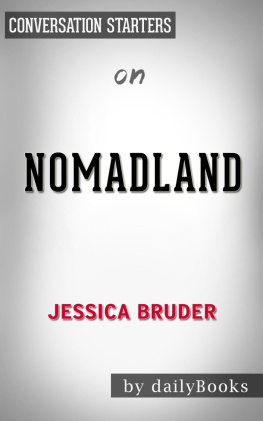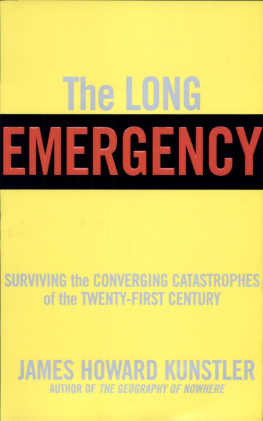Jessica Bruder - Nomadland: Surviving America in the Twenty-First Century
Here you can read online Jessica Bruder - Nomadland: Surviving America in the Twenty-First Century full text of the book (entire story) in english for free. Download pdf and epub, get meaning, cover and reviews about this ebook. year: 2017, publisher: W. W. Norton & Company, genre: Detective and thriller. Description of the work, (preface) as well as reviews are available. Best literature library LitArk.com created for fans of good reading and offers a wide selection of genres:
Romance novel
Science fiction
Adventure
Detective
Science
History
Home and family
Prose
Art
Politics
Computer
Non-fiction
Religion
Business
Children
Humor
Choose a favorite category and find really read worthwhile books. Enjoy immersion in the world of imagination, feel the emotions of the characters or learn something new for yourself, make an fascinating discovery.
- Book:Nomadland: Surviving America in the Twenty-First Century
- Author:
- Publisher:W. W. Norton & Company
- Genre:
- Year:2017
- Rating:5 / 5
- Favourites:Add to favourites
- Your mark:
- 100
- 1
- 2
- 3
- 4
- 5
Nomadland: Surviving America in the Twenty-First Century: summary, description and annotation
We offer to read an annotation, description, summary or preface (depends on what the author of the book "Nomadland: Surviving America in the Twenty-First Century" wrote himself). If you haven't found the necessary information about the book — write in the comments, we will try to find it.
Nomadland: Surviving America in the Twenty-First Century — read online for free the complete book (whole text) full work
Below is the text of the book, divided by pages. System saving the place of the last page read, allows you to conveniently read the book "Nomadland: Surviving America in the Twenty-First Century" online for free, without having to search again every time where you left off. Put a bookmark, and you can go to the page where you finished reading at any time.
Font size:
Interval:
Bookmark:

Nomadland
SURVIVING AMERICA IN THE
TWENTY-FIRST CENTURY
JESSICA BRUDER

W. W. NORTON & COMPANY
INDEPENDENT PUBLISHERS SINCE 1923
NEW YORK LONDON
For Dale
Theres a crack in everything. That is how the light gets in.
LEONARD COHEN
The capitalists dont want anyone living off their economic grid.
ANONYMOUS COMMENTER,
AZDAILYSUN.COM
AS I WRITE THIS, they are scattered across the country
In Drayton, North Dakota, a former San Francisco cabdriver, sixty-seven, labors at the annual sugar beet harvest. He works from sunrise until after sunset in temperatures that dip below freezing, helping trucks that roll in from the fields disgorge multi-ton loads of beets. At night he sleeps in the van that has been his home ever since Uber squeezed him out of the taxi industry and making the rent became impossible.
In Campbellsville, Kentucky, a sixty-six-year-old exgeneral contractor stows merchandise during the overnight shift at an Amazon warehouse, pushing a wheeled cart for miles along the concrete floor. Its mind-numbing work and she struggles to scan each item accurately, hoping to avoid getting fired. In the morning she returns to her tiny trailer, moored at one of several mobile home parks that contract with Amazon to put up nomadic workers like her.
In New Bern, North Carolina, a woman whose home is a teardrop-style trailerso small it can be pulled with a motorcycleis couch-surfing with a friend while hunting for work. Even with a masters degree, the thirty-eight-year-old Nebraska native cant find a job despite filling out hundreds of applications in the past month alone. She knows the sugar beet harvest is hiring, but traveling halfway across the country would require more cash than she has. Losing her job at a non-profit several years ago is one of the reasons she moved into the trailer in the first place. After the funding for her position ran out, she couldnt afford rent on top of paying off student loans.
In San Marcos, California, a thirtysomething couple in a 1975 GMC motorhome is running a roadside pumpkin stand with a childrens carnival and petting zoo, which they had five days to set up from scratch on a vacant dirt lot. In a few weeks theyll switch to selling Christmas trees.
In Colorado Springs, Colorado, a seventy-two-year-old vandweller who cracked three ribs doing a campground maintenance job is recuperating while visiting with family.
THERE HAVE ALWAYS BEEN ITINERANTS, drifters, hobos, restless souls. But now, in the second millennium, a new kind of wandering tribe is emerging. People who never imagined being nomads are hitting the road. Theyre giving up traditional houses and apartments to live in what some call wheel estatevans, secondhand RVs, school buses, pickup campers, travel trailers, and plain old sedans. They are driving away from the impossible choices that face what used to be the middle class. Decisions like:
Would you rather have food or dental work? Pay your mortgage or your electric bill? Make a car payment or buy medicine? Cover rent or student loans? Purchase warm clothes or gas for your commute?
For many the answer seemed radical at first.
You cant give yourself a raise, but what about cutting your biggest expense? Trading astick-and-brick domicile for life on wheels?
Some call them homeless. The new nomads reject that label. Equipped with both shelter and transportation, theyve adopted a different word. They refer to themselves, quite simply, as houseless.
From a distance, many of them could be mistaken for carefree retired RVers. On occasions when they treat themselves to a movie or dinner at a restaurant, they blend with the crowd. In mind-set and appearance, they are largely middle class. They wash their clothes at Laundromats and join fitness clubs to use the showers. Many took to the road after their savings were obliterated by the Great Recession. To keep their gas tanks and bellies full, they work long hours at hard, physical jobs. In a time of flat wages and rising housing costs, they have unshackled themselves from rent and mortgages as a way to get by. They are surviving America.
But for themas for anyonesurvival isnt enough. So what began as a last-ditch effort has become a battle cry for something greater. Being human means yearning for more than subsistence. As much as food or shelter, we require hope.
And there is hope on the road. Its a by-product of forward momentum. A sense of opportunity, as wide as the country itself.
A bone-deep conviction that something better will come. Its just ahead, in the next town, the next gig, the next chance encounter with a stranger.
As it happens, some of those strangers are nomads, too. When they meetonline, or at a job, or camping way off the gridtribes begin to form. Theres a common understanding, a kinship. When someones van breaks down, they pass the hat. Theres a contagious feeling: Something big is happening. The country is changing rapidly, the old structures crumbling away, and theyre at the epicenter of something new. Around a shared campfire, in the middle of the night, it can feel like a glimpse of utopia.
As I write, it is autumn. Soon winter will come. Routine layoffs will start at the seasonal jobs. The nomads will pack up camp and return to their real homethe roadmoving like blood cells through the veins of the country. Theyll set out in search of friends and family, or just a place thats warm. Some will journey clear across the continent. All will count the miles, which unspool like a filmstrip of America. Fast-food joints and shopping malls. Fields dormant under frost. Auto dealerships, megachurches, and all-night diners. Featureless plains. Feedlots, dead factories, subdivisions, and big-box stores. Snowcapped peaks. The roadside reels past, through the day and into darkness, until fatigue sets in. Bleary-eyed, they find places to pull off the road and rest. In Walmart parking lots. On quiet suburban streets. At truck stops, amid the lullaby of idling engines. Then in the early morning hoursbefore anyone noticestheyre back on the highway. Driving on, theyre secure in this knowledge:
The last free place in America is a parking spot.
ON THE FOOTHILL FREEWAY, about an hour inland from Los Angeles, a mountain range looms ahead of northbound traffic, bringing suburbia to a sudden stop. This wilderness is the southern edge of the San Bernardino Mountains, a tall, precipitous escarpment in the words of the United States Geological Survey. Its part of a formation that began growing eleven million years ago along the San Andreas Fault and is still rising today, gaining a few millimeters each year as the Pacific and North American plates grind past each other. The peaks appear to grow much faster, however, when youre driving straight at them. Theyre the kind of sight that makes you sit up straighter and starts a swelling sensation in your chest, a feeling like helium crowding your ribcage, enough perhaps to carry you away.
Linda May grips her steering wheel and watches the approaching mountains through bifocals with rose-colored frames. Her silver hair, which falls past her shoulders, is pulled back from her face in a plastic barrette. She turns off the Foothill Freeway onto Highway 330, also known as City Creek Road. For a couple miles the pavement runs flat and wide. Then it tapers to a steep serpentine, with just one lane in either direction, starting the ascent into the San Bernardino National Forest.
The sixty-four-year-old grandmother is driving a Jeep Grand Cherokee Laredo, which was totaled and salvaged before she bought it off a tow lot. The check engine light is finickyit has a habit of flashing on when nothing is actually wrongand a close look reveals that the white paint on the hood, which was crumpled and replaced, is a half-shade off from the rest of the body. But after months of repairs the vehicle is finally roadworthy. A mechanic installed a new camshaft and lifters. Linda spruced up what she could, scrubbing the foggy headlights with an old T-shirt and insect repellant, a do-it-yourself trick. For the first time the Jeep is towing Lindas home: a tiny, pale yellow trailer she calls the Squeeze Inn. (If visitors dont get the name on first mention, she puts it in a sentenceYeah, theres room, squeeze in!and smiles, revealing deep laugh lines.) The trailer is a molded fiberglass relic, a Hunter Compact II, built in 1974 and originally advertised as a crowning achievement in travel for fun that would follow like a kitten on the open road, track like a tiger when the going gets rough. Four decades along, the Squeeze Inn feels like a charmingly retro life-support capsule: a box with rounded edges and sloped sides, geometrically reminiscent of the Styrofoam clamshell containers once used at hamburger joints. Inside it measures ten feet from end to end, roughly the same interior length as the covered wagon that carried Lindas own great-great-great-grandmother across the country more than a century ago. It has some distinctive 1970s touches: quilted, cream-colored pleather covering the walls and ceiling, linoleum with a mustard and avocado pattern on the floor. The roof is just high enough for Linda to stand. After buying the trailer at auction for $1,400, she described it on Facebook. Its 5'3" inside and I am 5'2", she wrote. Perfect fit.
Next pageFont size:
Interval:
Bookmark:
Similar books «Nomadland: Surviving America in the Twenty-First Century»
Look at similar books to Nomadland: Surviving America in the Twenty-First Century. We have selected literature similar in name and meaning in the hope of providing readers with more options to find new, interesting, not yet read works.
Discussion, reviews of the book Nomadland: Surviving America in the Twenty-First Century and just readers' own opinions. Leave your comments, write what you think about the work, its meaning or the main characters. Specify what exactly you liked and what you didn't like, and why you think so.











